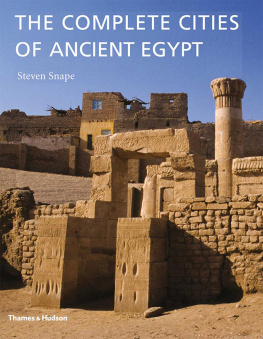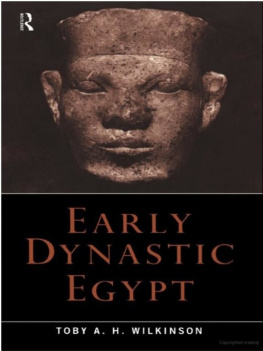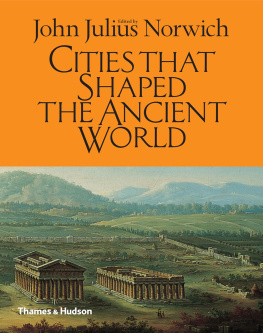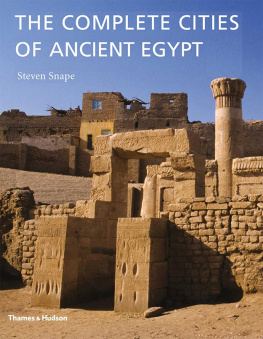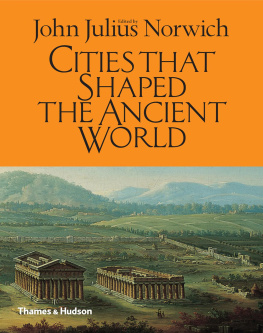About the Author
Steven Snape teaches Egyptian Archaeology at the University of Liverpool. Settlement archaeology in Egypt is one of his major research subjects, particularly during his excavations at the Ramesside fortress town of Zawiyet Umm el-Rakham. His publications include Ancient Egyptian Tombs: The Culture of Life and Death (2011).
Other titles of interest published by
Thames & Hudson include:
The Complete Temples of Ancient Egypt
The Complete Valley of the Kings
The Seventy Great Mysteries of Ancient Egypt
The City of Akhenaten and Nefertiti: Amarna and Its People
Abydos: Egypt's First Pharaohs and the Cult of Osiris
Cities That Shaped the Ancient World
See our websites
www.thamesandhudson.com
www.thamesandhudsonusa.com
For Joyce
CONTENTS
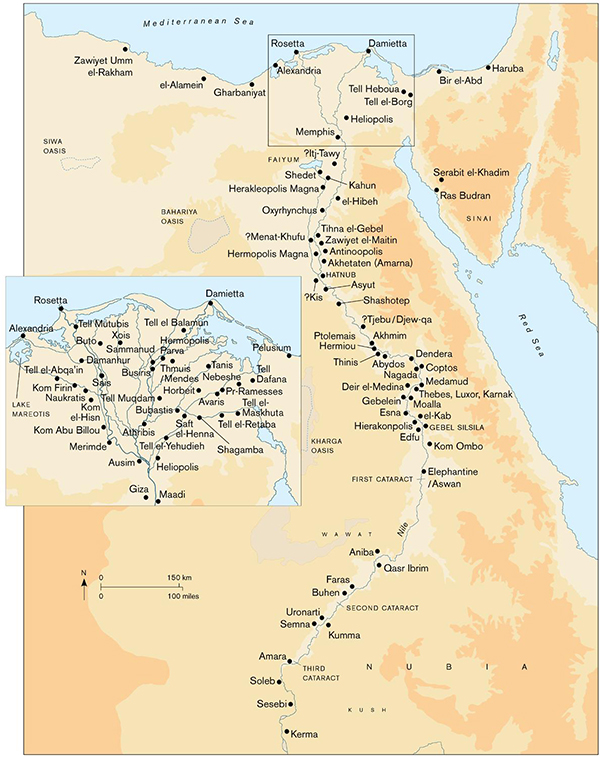
Map of Egypt showing the major sites and settlements discussed in this book.
It is easy to think of ancient Egypt as a land filled with tombs and temples built by a people obsessed with death and their gods. This impression is due to a combination of factors, the most important being the choices the ancient Egyptians made in the allocation of resources to different parts of the built environment, which led to the most durable materials being used for their most important structures, temples and tombs, rather than ordinary dwellings; the locations chosen for different types of structure, resulting in the most visible monuments today being those in spaces often set apart from urban life; and the choices, often in favour of spectacular monuments over more mundane settlement sites, made by the archaeologists who have explored the physical heritage of ancient Egypt through excavation and survey.
However, although its great monuments are the defining feature of ancient Egypt to modern observers, to the ancient Egyptians themselves the royal pyramids of the Old Kingdom and the enormous stone temples of the New Kingdom were exceptional, unusual and generally inaccessible parts of their everyday built environment. This book attempts to explore ancient Egyptian cities to try to find what was usual as well as what was unusual. We shall learn that it cannot be truly complete since the destruction of ancient settlement remains has robbed us of much of the archaeological record, but we shall find partial compensation in looking beyond settlements that we might think of as cities to explore towns, villages, indeed a whole variety of locations where the ancient Egyptians lived their lives.
This book will explore the cities and towns of ancient Egypt first by looking at the evidence we have for who built them, why they were built and for whom they were intended. The role of the king as an initiator of major projects (including urban development) is very important, as is the space that was created within cities for temples, the residences of the gods. But we shall also try to understand the ways in which the built environment of cities, towns and villages throughout Egypt was created and adapted by ordinary Egyptians to serve their everyday lives from 3500 BC to AD 641. Finally, we shall take a journey down the Nile, and visit adjacent areas inhabited by the Egyptians to see what remains, and what we know to have once existed, of the cities and towns of ancient Egypt.
The Call of the Pyramid
Egypts monuments demand attention. They were designed to impress both men and gods and they continue to awe both the casual tourist and supposedly serious scholar. Indeed, pyramid investigation in its variety of forms has been a permanent feature of Egyptology (in its broadest sense) since its traditional birth as a serious discipline when Napoleons savants invaded in 1798.
Ancient towns were not so immediately attractive to early archaeologists; for one thing it was difficult to find them and when one did it was often in the form of great mounds of potsherds and broken bricks, which did not make an inviting prospect for excavation. An obvious comparison can be seen today at Giza, where the very visible Old Kingdom pyramids have an immediate appeal, although their obvious magnificence is not necessarily equalled by their contribution to a wider understanding of the ancient Egyptians, apart from teaching us of their ability to move vast quantities of stone. By contrast, the pyramid towns at the same site have long been invisible, but are packed with vital information, which has only been recently revealed after careful archaeological excavation and analysis.
Almost as attractive to early explorers were the heavily decorated elite tombs and royal temples that similarly tempted scholars into the study of monumental architecture, its functions and motifs. They also encouraged an interest in two other wide-ranging topics that have had a substantial impact on the development of the intellectual focus of Egyptology.
Pictures and Words
One of these topics was royal and private art in two and three dimensions. To give just two examples, colossal royal sculpture invited studies of the superhuman aspects of Egyptian kingship, while the decorative schemes of elite private tombs with their daily life scenes of ancient Egyptians doing ordinary ancient Egyptian things, seemed to offer a way of understanding many aspects of the political, social and religious lives of non-royal people.
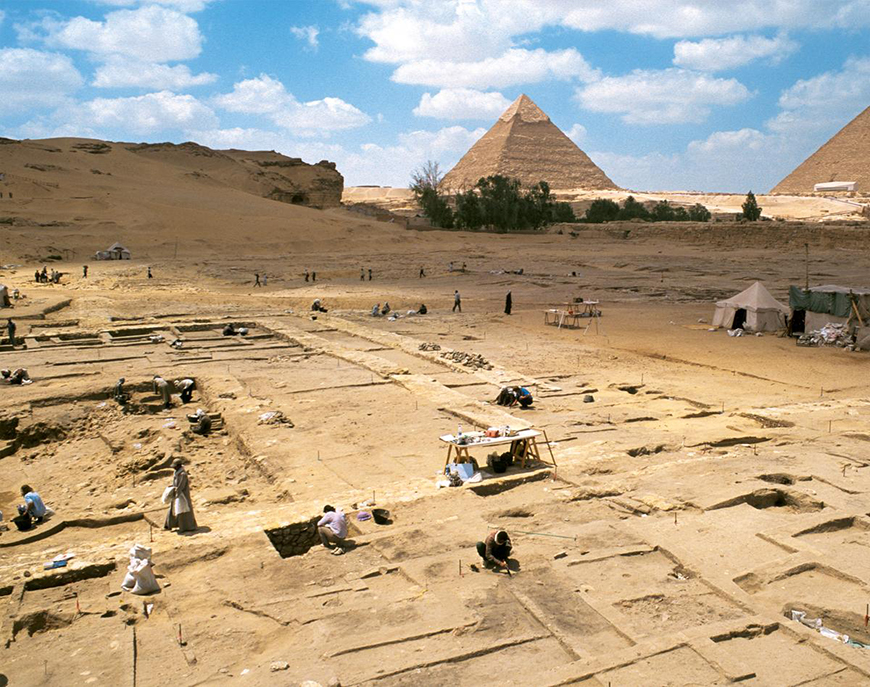
Excavations at the town attached to the tomb of the Old Kingdom Queen Khentkawes at Giza, in the shadow of the pyramids of Khafre and Khufu. 2013 Ancient Egypt Research Associates.

The funerary papyrus of the royal scribe Nakht shows him in the afterlife with the ideal accommodation for a high-ranking New Kingdom official: a comfortable house (right) and a garden around a pool (left). Scenes such as this provide evidence for what Egyptian homes would have looked like. Werner Forman Archive/British Museum London.
To a large extent, the decoration and contents of tombs became a substitute for settlement sites in the study of a range of domestic and industrial activities until fairly recently it was commonplace to read accounts of, say, baking and brewing in ancient Egypt that were based not on archaeological finds from real bakeries and breweries, but on the illustrations of such activities on the walls of private tombs, and on wooden models within those tombs. This source of evidence, to some degree, it was thought, negated the necessity of digging for the badly preserved remains of such structures given that they were illustrated in such glorious colours, often in a strip-cartoon-like way.
The second topic was even more pervasive. Monuments from royal temples to private tombs were covered by, and filled with objects containing, hieroglyphic text. The daily life scenes would be less informative if they did not also carry explanatory captions and the colossal statues would be significantly more enigmatic if they were not labelled with the name and titles of their royal or divine owner. The ability to read hieroglyphic (and other) texts, which was gained early in the modern study of ancient Egypt, provided the single most important tool in understanding this ancient civilization. After all, what could be more authentic and more informative than hearing the Egyptians speaking to us in their own voices?

